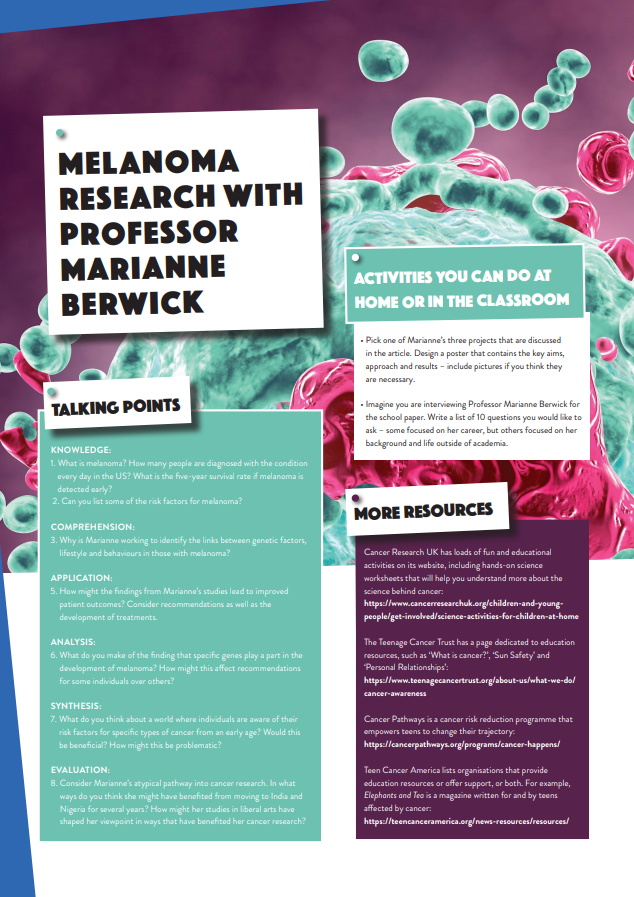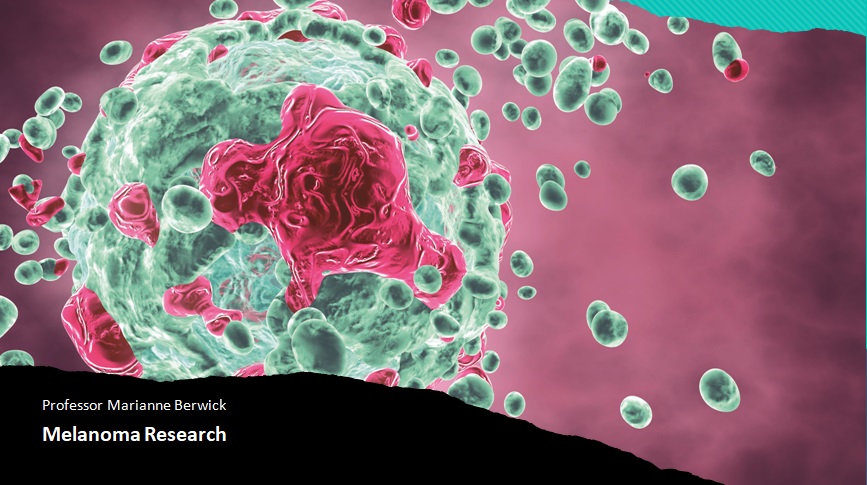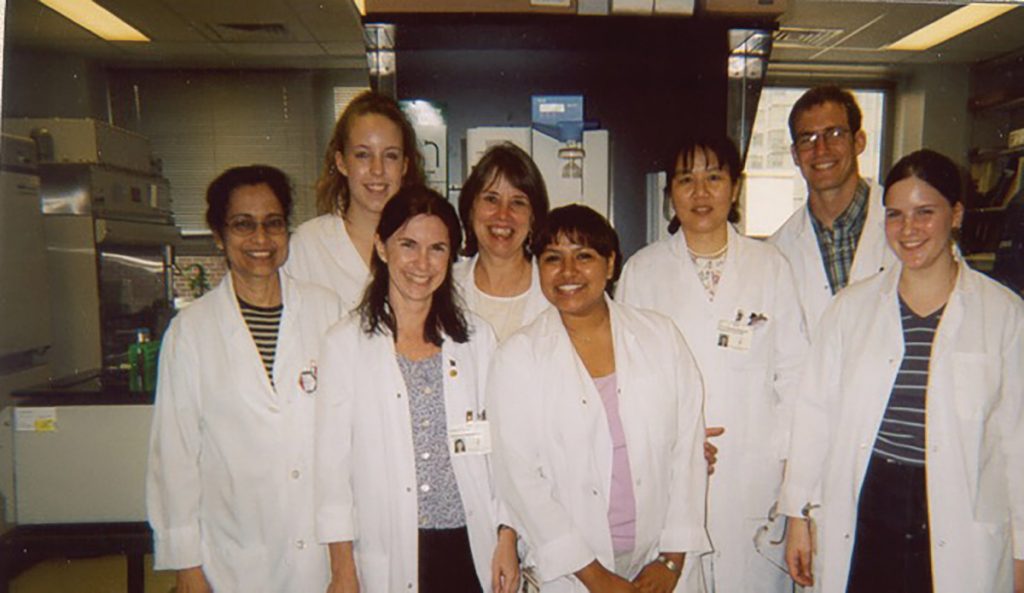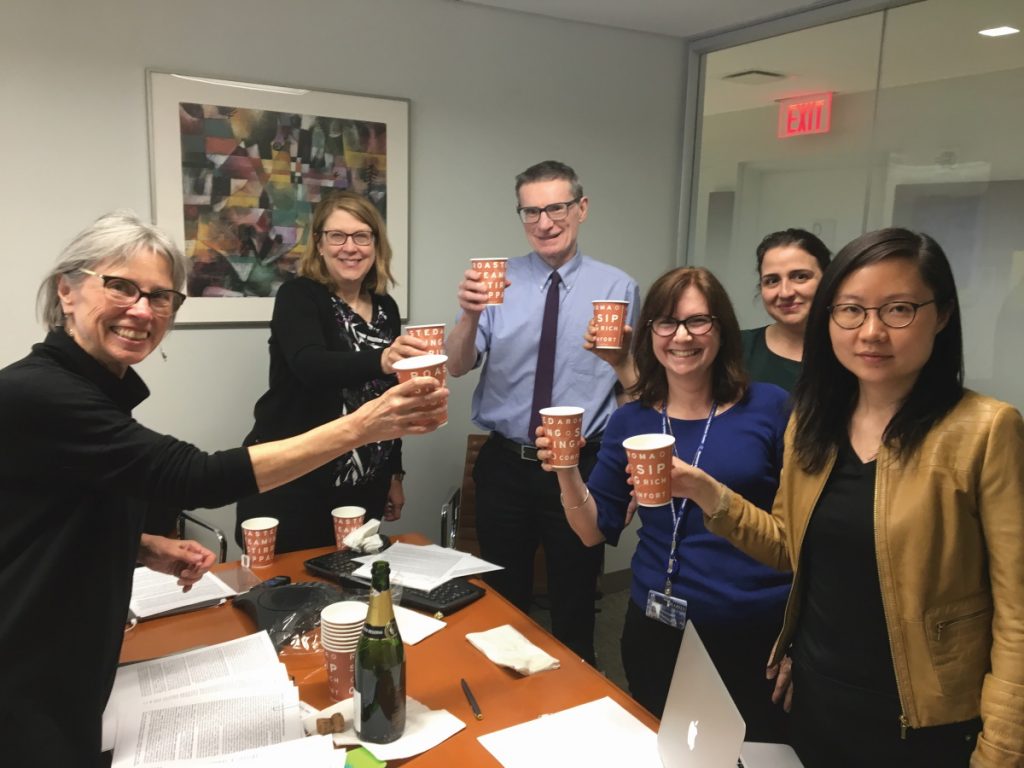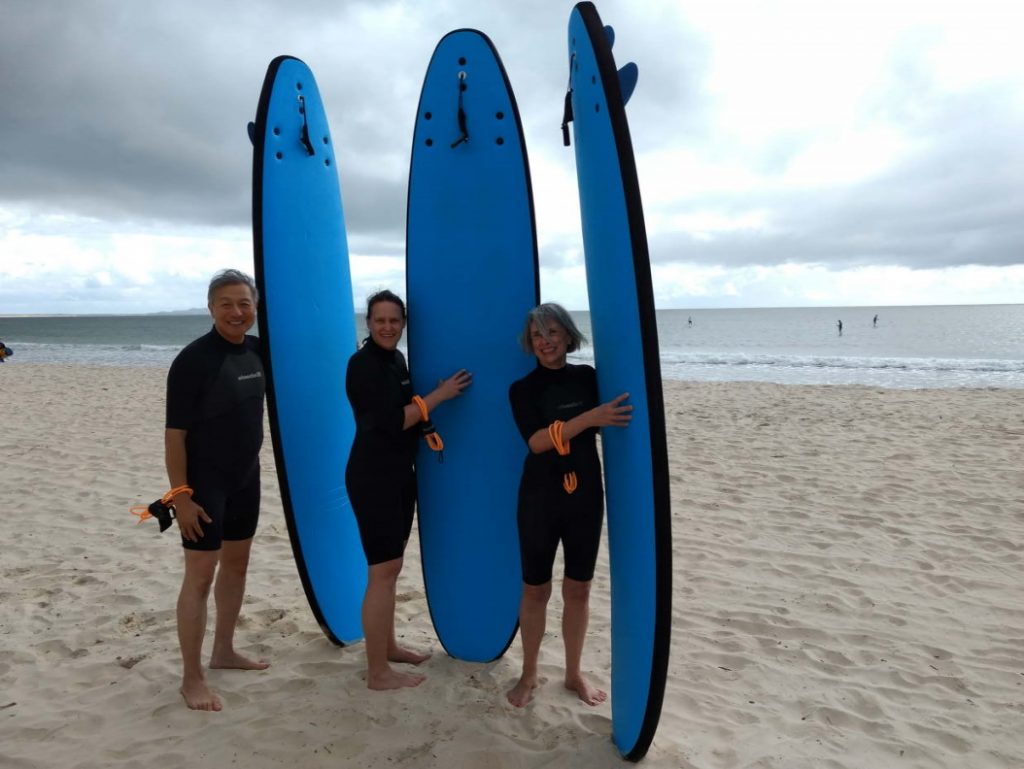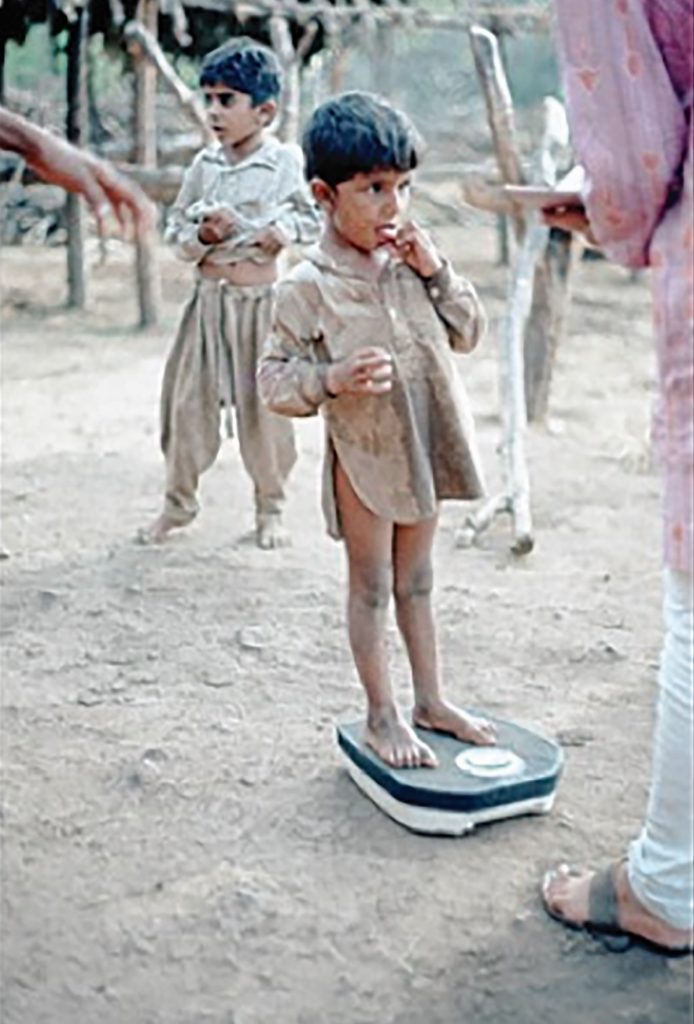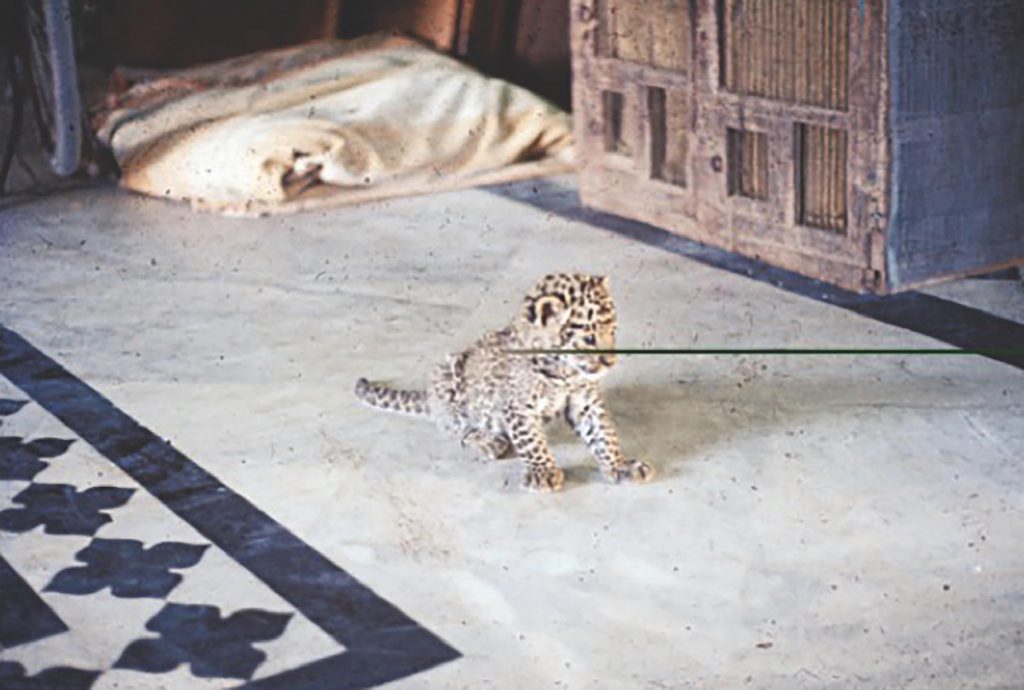An inspirational insight into advancing understanding of melanoma
Professor Marianne Berwick is a highly inspirational cancer researcher with a particular interest in melanoma. Her atypical career pathway saw her move to India and Nigeria for several years before engaging in several projects that aim to help prevent and treat melanoma
TALK LIKE A CANCER RESEARCHER
PROGNOSIS – a medical term denoting the predicted development of a disease
POLYMORPHISM – one of two or more variants of a particular DNA sequence
CDKN2A – also known as cyclin-dependent kinase inhibitor 2A, this gene is located at chromosome 9 in humans and was first identified in 1994
MC1R – one of the genes associated with red hair
NEVUS – the medical term for a mole. Nevi is the plural of nevus
ATYPICAL – not typical, irregular
GENOTYPE – the genetic make-up of an organism
PHENOTYPE – the characteristics of a living thing, especially qualities you can see, such as hair and eye colour
Melanoma is a type of skin cancer that is said to be diagnosed in more than 9,500 people in the USA every day. Incidence of melanoma is extremely high when compared to other forms of cancer and it is estimated that at least one in five Americans will develop skin cancer by the age of 70. However, when melanoma is detected early, the five-year survival rate is 99 per cent and this encouraging statistic is in no small part thanks to researchers like Professor Marianne Berwick.
Marianne is a cancer researcher with more than 30 years’ experience conducting studies and experiments on melanoma. She leads a team based at the UNM Comprehensive Cancer Center in New Mexico, USA, which is focused on preventing melanoma and helping melanoma patients survive the cancer. Her research takes the form of three main areas, which are detailed below in their own specific sections.
INTERMEL
Marianne is the principal investigator of InterMEL, an international consortium composed of 15 centres doing important work in the treatment and prevention of melanoma. The centres have come together with the goal to identify features of a tumour within its individual cells, particularly those that are associated with survival in patients with stage II and stage III melanoma.
As it stands, when a patient is diagnosed with melanoma, their prognosis is solely based on the stage of the disease. This essentially means that if the cancer has advanced to a particular stage, clinicians will automatically predict a specific outcome that the patient then has to come to terms with. However, this rigid approach is unsuitable for patients at stage II and III, not least because the mortality rate for individuals with these stages of melanoma varies wildly. Indeed, research shows that the mortality rate can be anywhere between 13 per cent and 68 per cent, so some flexibility is needed when giving a prognosis.
WHAT ARE THE ISSUES AND HOW IS INTERMEL WORKING TO OVERCOME THEM?
Part of the difficulty with prognosis of melanoma is that scientists do not fully understand why some tumours are more aggressive than others, so it is difficult to compare one tumour with another; two tumours of the same size in two different patients could easily develop in completely different ways, making general prognoses unreliable.
Marianne and her team believe that looking at the different genetic features of tumour cells provides an effective indication of which melanomas are more likely to come back or grow. If enough genetic data can be gathered, then the team could develop a more reliable means of predicting outcomes in patients. This would help to identify the best treatment methods and course of action for specific patients.
GEM
The Genes, Environment & Melanoma (GEM) study is also led by Marianne. It aims to capture a range of different types of information which could help with prevention and treatment of melanoma. More than 3,500 people across various geographic regions in North America, Europe and Australia participated in the study, with the team gathering information about their DNA, lifestyle and other personal information.
Marianne and the team wanted to examine the genetic factors associated with melanoma and what people’s relationship with sun exposure was.
WHAT RESULTS CAME FROM THE STUDY?
The team uncovered some unique insights relating to the influence of the genes CDKN2A and MC1R in the risk of melanoma, as well as the role that various DNA polymorphisms and exposure to the sun plays in the onset of melanoma. The next step is to examine the disease histories of the participants to see whether the history of sun exposure and genetic factors are related to the chances of surviving melanoma. The findings will influence the recommendations for preventive measures for melanoma, as well as possible treatment methods.
SONIC
Marianne contributed to a paper that was published in the American Journal of Epidemiology concerning nevus formation. Nevi have been identified as possible precursors of melanoma and are considered some of the most important known risk factors for the disease.
Repeated studies have shown that an important time for the formation and evolution of nevi is during adolescence. In the majority of cases, typical moles form during this time period and are almost always harmless, but there are instances where atypical moles form and these are considered the strongest indicator of melanoma risk.
WHAT IS THE PURPOSE OF THE STUDY?
The Study of Nevi in Children (SONIC) was one that attempted to understand the relationship between sun exposure and nevi – especially given the strong link between nevi and melanoma. The investigators studied nevi in a group of children in Massachusetts, with the overall objective being the documentation of the natural history of nevi.
The team used digital photography to capture images of nevi and then assessed the associations with sun exposure and sun protection behaviours. Ultimately, through conducting follow-up studies of the group, the team provided further understanding of the associations of genotype, phenotype and sun exposure with the evolution of individual moles.
Ultimately, Marianne’s studies are advancing our understanding of melanoma, including the risk factors and how they relate to behaviours and the likelihood of the cancer developing. Her expertise and clear passion for the subject helps to demonstrate just how important it is to find something you love doing. Marianne’s career pathway is unusual to say the least (read ‘How did Marianne become a cancer researcher?’, below), but this has given her a unique perspective, which has clearly aided her research.
Reference
https://doi.org/10.33424/FUTURUM130
Marianne’s Molecular Epidemiology Laboratory in 2000 at the Memorial Sloan Kettering Cancer Center in New York, USA.
TALK LIKE A CANCER RESEARCHER
PROGNOSIS – a medical term denoting the predicted development of a disease
POLYMORPHISM – one of two or more variants of a particular DNA sequence
CDKN2A – also known as cyclin-dependent kinase inhibitor 2A, this gene is located at chromosome 9 in humans and was first identified in 1994
MC1R – one of the genes associated with red hair
NEVUS – the medical term for a mole. Nevi is the plural of nevus
ATYPICAL – not typical, irregular
GENOTYPE – the genetic make-up of an organism
PHENOTYPE – the characteristics of a living thing, especially qualities you can see, such as hair and eye colour
Melanoma is a type of skin cancer that is said to be diagnosed in more than 9,500 people in the USA every day. Incidence of melanoma is extremely high when compared to other forms of cancer and it is estimated that at least one in five Americans will develop skin cancer by the age of 70. However, when melanoma is detected early, the five-year survival rate is 99 per cent and this encouraging statistic is in no small part thanks to researchers like Professor Marianne Berwick.
Marianne is a cancer researcher with more than 30 years’ experience conducting studies and experiments on melanoma. She leads a team based at the UNM Comprehensive Cancer Center in New Mexico, USA, which is focused on preventing melanoma and helping melanoma patients survive the cancer. Her research takes the form of three main areas, which are detailed below in their own specific sections.
INTERMEL
Marianne is the principal investigator of InterMEL, an international consortium composed of 15 centres doing important work in the treatment and prevention of melanoma. The centres have come together with the goal to identify features of a tumour within its individual cells, particularly those that are associated with survival in patients with stage II and stage III melanoma.
As it stands, when a patient is diagnosed with melanoma, their prognosis is solely based on the stage of the disease. This essentially means that if the cancer has advanced to a particular stage, clinicians will automatically predict a specific outcome that the patient then has to come to terms with. However, this rigid approach is unsuitable for patients at stage II and III, not least because the mortality rate for individuals with these stages of melanoma varies wildly. Indeed, research shows that the mortality rate can be anywhere between 13 per cent and 68 per cent, so some flexibility is needed when giving a prognosis.
WHAT ARE THE ISSUES AND HOW IS INTERMEL WORKING TO OVERCOME THEM?
Part of the difficulty with prognosis of melanoma is that scientists do not fully understand why some tumours are more aggressive than others, so it is difficult to compare one tumour with another; two tumours of the same size in two different patients could easily develop in completely different ways, making general prognoses unreliable.
Marianne and her team believe that looking at the different genetic features of tumour cells provides an effective indication of which melanomas are more likely to come back or grow. If enough genetic data can be gathered, then the team could develop a more reliable means of predicting outcomes in patients. This would help to identify the best treatment methods and course of action for specific patients.
GEM
The Genes, Environment & Melanoma (GEM) study is also led by Marianne. It aims to capture a range of different types of information which could help with prevention and treatment of melanoma. More than 3,500 people across various geographic regions in North America, Europe and Australia participated in the study, with the team gathering information about their DNA, lifestyle and other personal information.
Marianne and the team wanted to examine the genetic factors associated with melanoma and what people’s relationship with sun exposure was.
WHAT RESULTS CAME FROM THE STUDY?
The team uncovered some unique insights relating to the influence of the genes CDKN2A and MC1R in the risk of melanoma, as well as the role that various DNA polymorphisms and exposure to the sun plays in the onset of melanoma. The next step is to examine the disease histories of the participants to see whether the history of sun exposure and genetic factors are related to the chances of surviving melanoma. The findings will influence the recommendations for preventive measures for melanoma, as well as possible treatment methods.
SONIC
Marianne contributed to a paper that was published in the American Journal of Epidemiology concerning nevus formation. Nevi have been identified as possible precursors of melanoma and are considered some of the most important known risk factors for the disease.
Repeated studies have shown that an important time for the formation and evolution of nevi is during adolescence. In the majority of cases, typical moles form during this time period and are almost always harmless, but there are instances where atypical moles form and these are considered the strongest indicator of melanoma risk.
WHAT IS THE PURPOSE OF THE STUDY?
The Study of Nevi in Children (SONIC) was one that attempted to understand the relationship between sun exposure and nevi – especially given the strong link between nevi and melanoma. The investigators studied nevi in a group of children in Massachusetts, with the overall objective being the documentation of the natural history of nevi.
The team used digital photography to capture images of nevi and then assessed the associations with sun exposure and sun protection behaviours. Ultimately, through conducting follow-up studies of the group, the team provided further understanding of the associations of genotype, phenotype and sun exposure with the evolution of individual moles.
Ultimately, Marianne’s studies are advancing our understanding of melanoma, including the risk factors and how they relate to behaviours and the likelihood of the cancer developing. Her expertise and clear passion for the subject helps to demonstrate just how important it is to find something you love doing. Marianne’s career pathway is unusual to say the least (read ‘How did Marianne become a cancer researcher?’ below), but this has given her a unique perspective, which has clearly aided her research.
 PROFESSOR MARIANNE BERWICK
PROFESSOR MARIANNE BERWICK
Division of Epidemiology, Department of Internal Medicine, UNM Comprehensive Cancer Center, USA
FIELD OF RESEARCH: Melanoma
RESEARCH: Marianne has worked in the area of cancer prevention and aetiology for 30 years. Her particular focus is on melanoma prevention and survival and she has several projects on the go with that ultimate aim in mind.
FUNDERS: National Institutes of Health, National Cancer Institute. Grant numbers: NIH/NCI P01 CA206980-01A1, NIH/NCI 5R01CA233524-02, NIH/NCI P30CA11800-16
 PROFESSOR MARIANNE BERWICK
PROFESSOR MARIANNE BERWICK
Division of Epidemiology, Department of Internal Medicine, UNM Comprehensive Cancer Center, USA
FIELD OF RESEARCH: Melanoma
RESEARCH: Marianne has worked in the area of cancer prevention and aetiology for 30 years. Her particular focus is on melanoma prevention and survival and she has several projects on the go with that ultimate aim in mind.
FUNDERS: National Institutes of Health, National Cancer Institute. Grant numbers: NIH/NCI P01 CA206980-01A1, NIH/NCI 5R01CA233524-02, NIH/NCI P30CA11800-16
ABOUT MELANOMA AND CANCER RESEARCH
There is a high chance that you have been affected by cancer in some way – whether that is through having had it yourself or knowing somebody who has had it. We all realise the importance of cancer research and the people who dedicate their lives to finding cures for cancers and advancing our understanding so that improved preventive measures can be developed.
Skin cancer and melanoma is one of the most prevalent cancers there is, although early detection significantly improves patient outcomes, and the mortality rate is relatively low compared with some other cancers. Marianne leads and has led several projects relating to melanoma, which aim to understand what makes some people more susceptible than others, but also why some tumours grow more aggressively than others. Her work over the past 30 years has helped significantly advance the field and all of us stand to benefit from this in some way, directly or indirectly.
WHAT ARE THE RISK FACTORS FOR DEVELOPING MELANOMA?
First, it is worth highlighting that melanoma is not common in young people, but as a person gets closer to adulthood the incidence goes up. To highlight this, the proportion of melanomas in people under the age of 20 is just 0.4 per cent, but it rises to 5.1 per cent among those aged 20-31.
There are several risk factors for developing melanoma, including having light hair, light eyes and skin that does not tan very well. “It is the intermittent sun exposure that leads to sunburn that is a major culprit in melanoma – people who tan well or who tan very gradually are less likely to develop melanoma,” explains Marianne. “One of the most surprising discoveries we have made over the years is that genetic factors are really important in getting melanoma and surviving it.”
Marianne and her team continue to work to understand more about these genetic factors, which have been shown to be important in the risk factors outlined above.
WOULD MARIANNE RECOMMEND A CAREER IN CANCER RESEARCH?
Of course, anybody who wishes to enter into the field of cancer research has Marianne’s blessing. It goes without saying that if this is a career you want to pursue then you are clearly motivated by helping people overcome the burdens of this terrible disease. “Cancer research is highly rewarding because you can see the people you are trying to help and hopefully diminish their chances of having a severe cancer,” says Marianne. “You may not be able to stop cancer, but it is possible to make it a less horrible disease through prevention and better treatments.” So, if this is an area you want to pursue, go for it!
EXPLORE A CAREER IN CANCER RESEARCH
• The National Cancer Institute is North America’s leader in cancer research. Its website is a treasure trove of the latest research, as well as news and events that should be of interest to a budding cancer researcher: www.cancer.gov
• The Melanoma Research Alliance does important work in advancing understanding of melanoma: www.curemelanoma.org
* The average salary for a medical scientist (which includes cancer researchers) is $84,810, although this is largely dependent on the level of experience and specific job role you are performing.
PATHWAY FROM SCHOOL TO CANCER RESEARCH
Marianne’s own experience is a little different from the normal pathway, but you should only speak from your own experience! Marianne therefore suggests that having a balance is important. “For me, a broad liberal arts education as well as a solid scientific foundation helped,” says Marianne. “Although I never majored in a scientific subject until graduate school, I had a good foundation in biology, chemistry and physiology – all in high school!”
https://study.com/articles/Cancer_Researcher_Job_Description_and_Education_Requirements.Html
HOW DID MARIANNE BECOMEA CANCER RESEARCHER?
TELL US A LITTLE ABOUT YOUR BACKGROUND.
I grew up in a rural area and raised sheep, goats, a horse and even a baby deer. This was without the help of my family, although they were very supportive of my interest in animals. This experience set me up for what was to come. I went to the University of California, Davis (UC Davis) as I really wanted to be a veterinarian, but the industry only admitted around 5 per cent of females at the time and I was not a stellar student. I have always liked learning by doing (such as raising animals) and believe this has helped me throughout my career.
YOU HAVE AN INCREDIBLY DIVERSE CAREER. HOW DID YOU GET INTO CANCER RESEARCH?
After two years at UC Davis, I transferred to the University of California, Los Angeles and decided to become a teacher for disadvantaged children. I did this for seven years before moving to the Gir Forest in India where the only Asiatic lions still live. This is where I studied the Maldhari, semi-nomadic buffalo graziers who lived in a teak-thorn forest. I tried to gain their trust by just talking with them, drinking tea and taking them to doctors when they were sick. After a year of this, they did trust me and joked with me a lot. Because I drove a jeep and wore pants [trousers], they asked me where my moustache was! When I went back to the US from India, I decided to go into public health to try to eliminate unhealthy living conditions. I was given the opportunity to go to Nigeria to do some research on arboviruses (viruses that are carried by mosquitoes and other arthropods). That was really difficult because the electricity was only on 50 per cent of the time, and my skin colour made me an obvious outsider so it took some people I met a while to get used to me.
When I got back to Yale University, I became a PhD student in environmental epidemiology and studied the impact of nitrogen dioxide from kerosene heaters on respiratory infections in Connecticut, USA. Then, one of my fellow student-colleagues was looking for a project director for a new melanoma study. I knew nothing about cancer, but I thought I could do it and started working on the role of screening (skin self-examination) for melanoma. One of my assistants had a 23-year-old daughter who had recently died from melanoma. Working with her gave me a strong passion to try to alleviate death from melanoma. Although only about 10 per cent of melanoma patients have illness severe enough to lead to death, those 10 per cent are very important to me.
WHERE DO YOU GET THE CONFIDENCE TO TRY NEW THINGS?
My difficult experience in Nigeria made me feel that I could do anything. Or rather, I felt that if I could isolate dengue virus in very difficult circumstances, trying something new – like molecular epidemiology, for example, even though I was not trained in biology – would be a piece of cake. So, after my PhD, I was offered a job at Memorial Sloan Kettering Cancer Center, one of the premier cancer centres in the world. I started a Molecular Epidemiology Laboratory where we worked with laboratory technicians and a few high school students, and were funded by the National Cancer Institute.
WITH ALL THESE EXPERIENCES UNDER YOUR BELT, WHAT HAS BEEN THE HIGHLIGHT?
Personally, I have been blessed with three wonderful children (now grown) and five grandchildren and a very supportive husband. Professionally, my work in India was lifechanging and our studies on melanoma have been extremely satisfying.
WHAT DO YOU KNOW NOW THAT YOU WISH YOU’D KNOWN WHEN YOU WERE YOUNGER?
That is a really tough question. I might have studied more, but, on the other hand, it is really important to follow your passions – they may change over time. Mine changed from loving working with animals to loving working with people, and then focusing on a relatively small group of people – those who might die from melanoma – to hopefully make a difference. Serendipity must be followed!
MARIANNE’S TOP TIPS
01 Find something that interests you and that you love to do and then do everything in your power to work towards that. Remember that you will be doing whatever you decide for a long time, so it is essential that it chimes with your passion!
02 There is nothing that says you absolutely have to stay on the path that you have decided to forge. There will always be opportunities to change direction, so be willing to make that change if the opportunity presents itself and if you think it is the right decision.
03 Try and ensure that your education is balanced, with consideration for arts subjects as well as the science subjects. Getting a grounding in a wide range of different areas will stand you in good stead throughout your career.
Write it in the comments box below and Marianne will get back to you. (Remember, researchers are very busy people, so you may have to wait a few days.)


